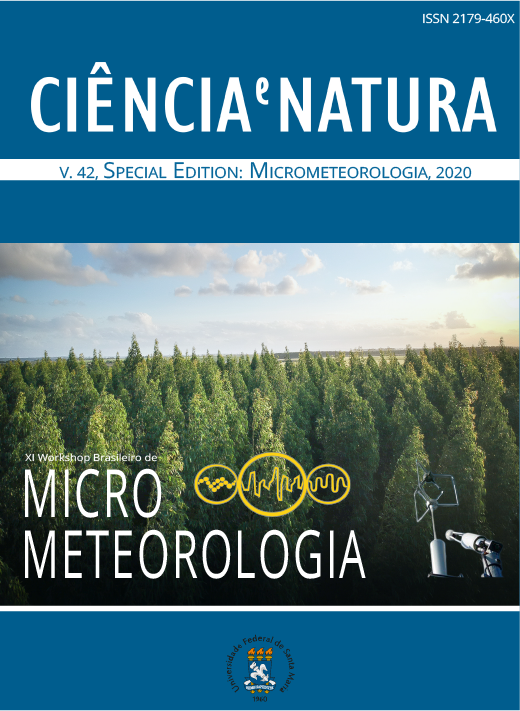Fazendas de vento”: um novo módulo para o BRAMS
DOI:
https://doi.org/10.5902/2179460X53219Palavras-chave:
Usina eólica, BRAMS, Turbina eólica, Tranferência de energia cinéticaResumo
Um novo módulo foi desenvolvido para o modelo BRAMS de área limitada para representar usinas eólicas. O modelo BRAMS foi desenvolvido para ser um sistema de previsão numérica de tempo e é atualmente empregado como o modelo operacional do CPTEC/INPE para previsão ambiental. O novo módulo foi capaz de simular o impacto de um conjunto de turbinas eólicas. O força de arraste adicional das turbinas altera a energia cinética turbulenta (ECT). Simulações foram realizadas com usinas eólicas instaladas no território brasileiro.Downloads
Referências
ADLER, R. F.; HUFFMAN, G. J.; CHANG, A.; FERRARO, R.; XIE, P.-P.; JANOWIAK, J.; RUDOLF, B.; SCHNEIDER, U.; CURTIS, S.; BOLVIN, D. et al. The version-2 global precipitation climatology project (GPCP) monthly precipitation analysis (1979–present). Journal of hydrometeorology, v. 4, n. 6, p. 1147-1167, 2003.
FITCH, A. C.; OLSON, J. B.; LUNQUIST, J. K.; DUDHIA, J.; GUPTA, A. K.; MICHALAKES, J.; BARSTAD, I. Local and mesoscale impacts of wind farms as parameterized in a mesoscale nwp model. Monthly Weather Review, v. 140, p. 3017–3038, 2012.
FREITAS, S. R.; LONGO, K. M.; AL. et. The coupled aerosol and tracer transport model to the Brazilian developments on the regional atmospheric modeling system (catt-brams) – part 1: Model description and evaluation. Atmospheric Chemistry and Physics, v. 9, p. 2843–2861, 2009.
FREITAS, S. R.; PANETTA, J.; LONGO, K. M.; AL. et. The brazilian developments on the regional atmospheric modeling system (BRAMS 5.2): an integrated environmental model tuned for tropical areas, geophysical model development. Atmospheric Chemistry and Physics, v. 130, p. 1–55, 2017.
LONGO, K. M.; FREITAS, S. R.; AL. et. The coupled aerosol and tracer transport model to the Brazilian developments on the regional atmospheric modeling system (CATT-BRAMS) – part 2: Model sensitivity to the biomass burning inventories. Atmospheric Chemistry and Physics, v. 10, p. 2843–2861, 2010.
LUZ, E. F. P.; SANTOS, A. F.; FREITAS, S. R.; Campos Velho, H. F.; GRELL, G. Optimization by firefly with predation for ensemble precipitation estimation using BRAMS. Atmospheric Chemistry and Physics, v. 5, n. 1A, p. 27–33, 2015.
SANTOS, A. F.; FREITAS, S. R.; MATTOS, J. a. G. Z.; Campos Velho, H. F.; GAN, M. A.; LUZ, E. F. P.; GRELL, G. A. Using the firefly optimization method to weight an ensemble of rainfall forecasts from the Brazilian developments on the regional atmospheric modeling system (BRAMS). Advances in Geosciences, v. 35, p. 123–136, 1982.
TRIPOLI, G. J.; COTTON, W. R. The colorado state university three-dimensional cloud/mesoscale model, part i: General theoretical framework and sensitivity experiments. Journal de Recherches Atmospheriques, v. 16, n. 3, p. 185–219, 1982.
Downloads
Publicado
Como Citar
Edição
Seção
Licença
Para acessar a DECLARAÇÃO DE ORIGINALIDADE E EXCLUSIVIDADE E CESSÃO DE DIREITOS AUTORAIS clique aqui.
Diretrizes Éticas para Publicação de Revistas
A revista Ciência e Natura está empenhada em garantir a ética na publicação e na qualidade dos artigos.
A conformidade com padrões de comportamento ético é, portanto, esperada de todas as partes envolvidas: Autores, Editores e Revisores.
Em particular,
Autores: Os Autores devem apresentar uma discussão objetiva sobre a importância do trabalho de pesquisa, bem como detalhes e referências suficientes para permitir que outros reproduzam as experiências. Declarações fraudulentas ou intencionalmente incorretas constituem comportamento antiético e são inaceitáveis. Artigos de Revisão também devem ser objetivos, abrangentes e relatos precisos do estado da arte. Os Autores devem assegurar que seu trabalho é uma obra totalmente original, e se o trabalho e / ou palavras de outros têm sido utilizadas, isso tem sido devidamente reconhecido. O plágio em todas as suas formas constitui um comportamento publicitário não ético e é inaceitável. Submeter o mesmo manuscrito a mais de um jornal simultaneamente constitui um comportamento publicitário não ético e é inaceitável. Os Autores não devem submeter artigos que descrevam essencialmente a mesma pesquisa a mais de uma revista. O Autor correspondente deve garantir que haja um consenso total de todos os Co-autores na aprovação da versão final do artigo e sua submissão para publicação.
Editores: Os Editores devem avaliar manuscritos exclusivamente com base no seu mérito acadêmico. Um Editor não deve usar informações não publicadas na própria pesquisa do Editor sem o consentimento expresso por escrito do Autor. Os Editores devem tomar medidas de resposta razoável quando tiverem sido apresentadas queixas éticas relativas a um manuscrito submetido ou publicado.
Revisores: Todos os manuscritos recebidos para revisão devem ser tratados como documentos confidenciais. As informações ou ideias privilegiadas obtidas através da análise por pares devem ser mantidas confidenciais e não utilizadas para vantagens pessoais. As revisões devem ser conduzidas objetivamente e as observações devem ser formuladas claramente com argumentos de apoio, de modo que os Autores possam usá-los para melhorar o artigo. Qualquer Revisor selecionado que se sinta desqualificado para rever a pesquisa relatada em um manuscrito ou sabe que sua rápida revisão será impossível deve notificar o Editor e desculpar-se do processo de revisão. Os Revisores não devem considerar manuscritos nos quais tenham conflitos de interesse resultantes de relacionamentos ou conexões competitivas, colaborativas ou outras conexões com qualquer dos autores, empresas ou instituições conectadas aos documentos.






